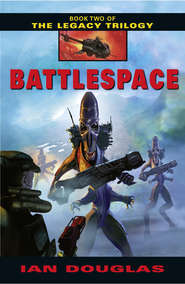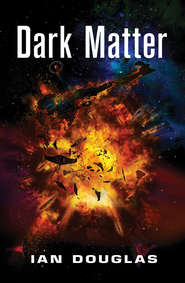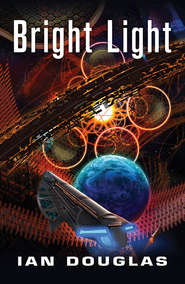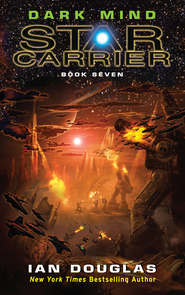По всем вопросам обращайтесь на: info@litportal.ru
(©) 2003-2024.
✖
The Star Carrier Series Books 1-3: Earth Strike, Centre of Gravity, Singularity
Настройки чтения
Размер шрифта
Высота строк
Поля
“Yes, Admiral?”
“You’ve done what you can, Paul,” Koenig told him. “It looks like the bastards aren’t going to follow us.”
Radniak’s eyes flicked away as he checked a readout outside the range of the holo’s pick-up. “It looks like they’re sending fighters after us, Admiral.”
“Fighters we can handle. I recommend you ass-end it out of there.”
The Spirit of Confederation was taking a hellacious pounding. Koenig was suggesting that Radniak rotate his ship another ninety degrees, so that the vessel’s stern was pointing in the direction she was moving, and her broad, water-filled forward shield cap was pointed at the enemy. By “ass-ending it out of there,” Radniak would be able to protect his ship from further incoming fire as the Confederation continued to accelerate out-system. Without the water shield, the crew might be subjected to dangerous doses of radiation as the Confederation approached c, but that was preferable to losing the entire vessel when her quantum power tap lost balance and detonated.
Radniak’s image shuddered, winked off, then came back up, rippling with static. “I think you’re right, Ad—” And Radniak was gone.
In the drone-relayed image nearby, white eruptions of light ate their way up the Spirit of Confederation’s spine, ripping out massive chunks of debris. One of her hab modules detached and flung itself outward, tumbling end over end as centripetal force sent it hurtling into space. The aft end appeared to be crumpling, folding in on itself. The black holes in the power center were loose, devouring the ship’s aft quarter in multi-ton bites.
The final explosion sent large chunks spraying along the ship’s direction of travel. The largest was the shield cap, tumbling end over end, leaving glittering and intertwining trails of ice crystals from a dozen ruptures in its wake. The intolerably brilliant core of the final explosion faded slowly in a flare of cooling plasma.
“Make to the other ships in our detachment,” Koenig said quietly. “Go to maximum acceleration.”
Two thousand officers and crew, plus God alone knew how many Marines and Mufrid refugees—gone.
God help them, he thought. God help us all. …
Chapter Fourteen
15 October 2404
Koenig’s Office
TC/USNA CVS America
Inbound, Sol System
0940 hours, TFT
“Dr. Wilkerson, Dr. George, and Dr. Brandt are all ready to link in, Admiral.”
Koenig looked up. Lieutenant Commander Nahan Cleary was his personal aide, which meant he often served as admiral’s secretary as frequently as Koenig’s secretarial AI. “Very well. I’ll take it here.”
He switched off the report he was currently writing and reclined his seat back. His office was fairly luxurious as military quarters went, more luxurious than he cared for, actually. There was a small lounge area over by the door, but he generally preferred to stay at his desk.
It was just as well he hadn’t gotten too used to the place. He couldn’t imagine that they would let him hold on to it much longer.
He brought up the link codes in his mind, letting the circuitry in the office connect with his in-head display. A window seemed to open and he stepped through … entering the carrier’s main med-research center. Earnest Brandt, the center’s senior medical officer, was already there. The virtual images of Dr. Anna George and Dr. Phillip Wilkerson winked on a moment later. Wilkerson was the head of America’s neuropsytherapy department, while George was a psytherapist on loan from the 1
Marine Expeditionary Force, and both had considerable experience with nonhuman psychology.
“Welcome to RC Central, Admiral,” Wilkerson’s virtual image said. “Thanks for linking in.”
“Does this mean you’ve gotten something, Doctor?” Koenig asked. “Something useful?”
Wilkerson shrugged, his lined face momentarily twisting in an expression of frustration. “That, sir, you’ll have to decide for yourself. We have established communications.”
“You know, sir,” Dr. George said, “it took over five years to establish basic communications with the Aglestch a century ago.”
“Yes,” Koenig replied, “and what we learned was LG. I thought you were using that with these … people.”
LG—LinguaGalactica—was an artificial language learned from the alien Aglestch. Evidently, it wasn’t one of that race’s native languages, but it was the way they communicated with the Sh’daar, their galactic masters. Koenig had assumed that the Turusch would know LG as well.
“We did, Admiral,” Wilkerson replied. “But it’s not that simple.”
“It never is.”
Wilkerson took a deep breath. “The Aglestch speak using phonemes generated through vibrating vocal cords like we do … except of course that they use air expressed from their first and second stomachs instead of from lungs or air sacs. The Turusch speak, we think, by modulating a humming or thrumming sound generated by vibrating diaphragms set within the dorsal carapace.”
“Meaning they don’t use words,” Koenig guessed.
“Exactly. Variations in pitch and tone, and the shifting harmonies created by four separate diaphragms, convey the information. Even the name ‘Turusch’ comes from the Agletsch. We don’t know what they call themselves.”
Brandt chuckled. “Maybe something like …” and he hummed the opening bar of a popular song, “We Were Strangers.”
“In four-part harmony,” Dr. George added.
“In any case,” Dr. Brandt said, “we did use LG as a basis—without it I expect it would have taken another five years or more to break the Turusch language and figure out how to speak it. We do appear to have established communication. At least … we’ve gotten some meaningful syntax out of them. But an awful lot of what they have to say doesn’t make much sense.”
“There’s also the xenopsych angle to consider, Admiral,” Dr. George told him. “I’ve been working with these two since we picked them up, and that was a couple of weeks ago. We don’t have a lot of leads on how they think.”
Koenig nodded. He knew how difficult it was to learn, not just another language, but a language spoken by a being with a completely nonhuman physiology and a completely alien psychology. One species—the primitive Glo of Epsilon Eridani II—appeared to communicate with one another by changing patterns of light and color on their black, oily torsos, using luminous chromatophores like the squid of Earth. The Glo had been known for almost two centuries now, and the experts still didn’t know if they were really talking … or if they even were intelligent enough to have anything to talk about. There was simply no comprehensible common ground from which to begin either a linguistic or a psychological understanding.
“I wasn’t expecting miracles, people,” Koenig told the three. “Let me have a look.”
“Yes, sir,” Wilkerson said. “Um … brace yourself. This can be unsettling.”
“We’ll be projecting into NTE robots,” Brandt added.
Koenig felt an inner shift, a momentary dizziness, and then he was someplace else, a ship’s compartment with blank, white-painted walls and one transplas wall. There were a number of machines in the compartment attached by universal joints and articulated metallic arms to the low overhead. Koenig’s own point of view now seemed to be residing within one of those devices, a white sphere supported on the end of a slender, jointed arm.
Non-terrestrial environmental robots—NTEs, or Noters—had been in wide use for almost three centuries, exploring places as hostile as the surface of Venus, the ice ridges of Europa, and the bottom of the Marianas Trench. The earliest versions had relayed photographs and telemetry from Mars and from Earth’s moon; later models had let human consciousness piggyback within their circuitry.
Readouts at the bottom of his visual field showed data on atmosphere, pressure, temperature, and other factors. It was as hot, Koenig noted, as boiling water, and the lighting in the room was sizzling with ultraviolet.
The Turusch were there, both of them, mottled black and dark brown, and gleaming wet in the harsh light. It was difficult to judge distance within this new body without practice, but they seemed to be about four meters away. If so, they were each half again longer than a human was tall and half a meter thick. The body might be described as slug-like, at least where the bare, mucus-wet skin was exposed, but large patches of its body were covered by what looked like sections of shell or carapace—large and irregular on the blunt end, and segmented like the scales of a snake along the belly, leaving most of the rest of the body nakedly exposed. Half-meter tentacles, black, whip-thin, and in constantly writhing motion, sprouted at seemingly random points from everywhere on the body except the armored parts.
One end was pointed. The other end, Koenig decided, must be the head, rounded and sheathed in three close-fitting sections of carapace, and showing recesses for at least two dozen eyes or other sense organs arranged in three lines running back from the blunt end. If those were eyes, they were deeply recessed and small, like tiny black marbles. Koenig wondered if that meant the Turusch were from a planet orbiting a star hotter and brighter than Sol. The ultraviolet baking the compartment seemed to validate the idea.
He saw nothing that resembled a mouth. He did see the diaphragms used for speech, however, two set on either side of the head carapace, which took up nearly a quarter of the creature’s length.
“So,” Koenig said. “Cephalopod? Reptile? Sea cucumber?”
“None of the above, Admiral,” Brandt said. “Remember … any resemblance to anything we know from Earth is superficial … either a matter of parallel evolution, or pure coincidence.”











